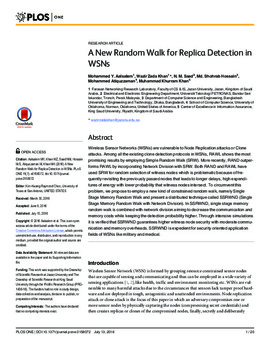| dc.contributor.author | Mohammed Y. Aalsalem | |
| dc.contributor.author | Wazir Zada Khan | |
| dc.contributor.author | N. M. Saad | |
| dc.contributor.author | Md. Shohrab Hossain | |
| dc.contributor.author | Mohammed Atiquzzaman | |
| dc.contributor.author | Muhammad Khurram Khan | |
| dc.date.accessioned | 2017-03-05T23:40:53Z | |
| dc.date.available | 2017-03-05T23:40:53Z | |
| dc.date.issued | 2016-07-13 | |
| dc.identifier.citation | Aalsalem MY, Khan WZ, Saad NM, Hossain MS, Atiquzzaman M, Khan MK (2016) A New Random Walk for Replica Detection in WSNs. PLoS ONE 11(7): e0158072. doi:10.1371/journal.pone.0158072 | en_US |
| dc.identifier.uri | https://hdl.handle.net/11244/49288 | |
| dc.description | The authors wish to thanks the anonymous reviewers for their valuable comments for the improvement of this manuscript. The authors wish to acknowledge the support and help of Deanship of Scientific Research at Jazan University and the authors also extend their sincere appreciations to Deanship of Scientific Research at King Saud University for its funding this Prolific Research Group (PRG-1436-16). | en_US |
| dc.description | | en_US |
| dc.description.abstract | Wireless Sensor Networks (WSNs) are vulnerable to Node Replication attacks or Clone attacks. Among all the existing clone detection protocols in WSNs, RAWL shows the most promising results by employing Simple Random Walk (SRW). More recently, RAND outperforms RAWL by incorporating Network Division with SRW. Both RAND and RAWL have used SRW for random selection of witness nodes which is problematic because of frequently revisiting the previously passed nodes that leads to longer delays, high expenditures of energy with lower probability that witness nodes intersect. To circumvent this problem, we propose to employ a new kind of constrained random walk, namely Single Stage Memory Random Walk and present a distributed technique called SSRWND (Single Stage Memory Random Walk with Network Division). In SSRWND, single stage memory random walk is combined with network division aiming to decrease the communication and memory costs while keeping the detection probability higher. Through intensive simulations it is verified that SSRWND guarantees higher witness node security with moderate communication and memory overheads. SSRWND is expedient for security oriented application fields of WSNs like military and medical. | en_US |
| dc.language.iso | en_US | en_US |
| dc.publisher | PLos One | |
| dc.relation.ispartofseries | PLoS ONE 11(7): e0158072 | |
| dc.relation.uri | http://www.plosone.org/article/info%3Adoi%2F10.1371%2Fjournal.pone.0158072 | |
| dc.rights | Attribution 3.0 United States | |
| dc.rights.uri | https://creativecommons.org/licenses/by/3.0/us/ | |
| dc.subject | Random walk,Cloning,Wireless sensor networks,Memory,Network analysis,Bioenergetics,Communication in health care,Telecommunications | en_US |
| dc.title | A New Random Walk for Replica Detection in WSNs | en_US |
| dc.type | Research Article | en_US |
| dc.description.peerreview | Yes | en_US |
| dc.description.peerreviewnotes | http://www.plosone.org/static/editorial#peer | en_US |
| dc.identifier.doi | 10.1371/journal.pone.0158072 | en_US |
| dc.rights.requestable | false | en_US |

